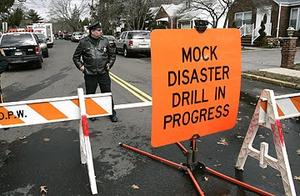DisastersDHS drill offers rare look at disaster preparedness
Anniston, Alabama, Center for Domestic Preparedness (CDP) offered another glimpse into disaster preparedness, this time focuses on disaster health care; a disaster drill observed by the media saw health care workers from throughout the United States acting out an explosion at a battery acid factory

Disaster drills are high-value exercises // Source: blogspot.com
Anniston, Alabama, Center for Domestic Preparedness (CDP) offered another glimpse into disaster preparedness, this time focuses on disaster health care. A mention in this week’s U.S. News and World Report inspired the Homeland Security facility to invite the media for a rare look at two different health care exercises, both of which seemed to come together as one.
Dixon Hayes writes that in this scenario, health care workers from throughout the United States acted out an explosion at a battery acid factory. Patients show up bleeding and in various states of shock and hysteria. More and more casualties pile up and workers have to set up a decontamination station outside the emergency room.
“There’s just a heightened sense of urgency,” says student Irene Thompson, who comes from a hospital in Maryland. “It’s not like sitting in a classroom, where you’re talking about it. We’re actually doing it.”
Lanny Campbell, a doctor from Idaho, sees all sorts of obstacles thrown at him in the exercise. At one point a generator failure shuts down power at the hospital, also part of the drill. “It’s quite overwhelming but it helps me prepare a little bit,” says Campbell.
Hayes writes that the CDP operates on the site of the old Fort McClellan Army base, and this exercise takes place at the Noble Training Center, which was once the base hospital. The CDP was training first responders from all over the country on nightmare terrorism scenarios even before the 9/11 terrorist attacks, and teaches responders about everything else from hurricanes to meth labs in cars.
Trainers say the training helps the responders with everything. Health care course manager Candice Gilliland says, “Essentially what they bring back is a little bit more knowledge to go back and check their emergency operations plan at their facility, and check and see, hey, do we have this accounted for, can we or are we prepared for this.”
Another course manager, John Skinner, describes how world events, from terrorism to natural disasters, shape what happens at the center. “We’re trying to keep up with the incidents that are happening throughout the world,” says Skinner. “We’ve had Katrina, which was a major incident for the United States, we’ve had fires, we’ve had floods, and every single one of those produced large numbers of casualties.”
The courses are paid for entirely out of DHS budget so hospitals, local police, fire departments, or others will not have to do so.
